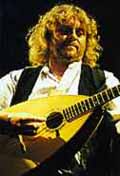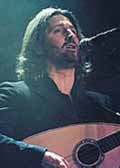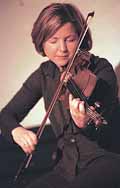 |
||
The Living Tradition
|
|
|||
| Tony McManus by Alan Murray |
|
|||
|
{graphic} |
||||
|
My son Paul was listening to Heather Heywood’s new CD shortly after it was released ... "That’ll be Tony McManus playing guitar then" he said. What is especially significant there is that Paul is a fiddler - not a guitarist - yet he recognised Tony’s sound and style instantly. On top of that - have a look yourself at the Scottish folk CD racks (visit Coda in Edinburgh to find one that’s still worth looking at!) and play a wee game. Look for a CD that has Tony McManus playing guitar on it. Now look for one that hasn’t. That may be more difficult. Mr McManus is a busy boy - on his own CDs, as a sensitive, skilled and sympathetic accompanist on CDs from luminaries like Kate Rusby, Brian McNeill, Catriona MacDonald, Billy Ross, Aileen Carr and Liz Doherty. On top of that, he’s half of what is, in this writer’s humble opinion, the finest CD of fiddle and guitar music in any genre - Return to Kintail, with fiddle maestro Alasdair Fraser. Tony was born in 1965 in Paisley and is self-taught. Like Martin Simpson from South of the Border, Tony’s blinding technique is tempered by with a deep love of traditional music - and Tony counts the music of Scotland, Ireland, Brittany, Galicia, Quebec, Asturies, Cape Breton and Eastern Europe in his definition of traditional music. He has earned the respect of present day guitar greats, such as Stefan Grossman, John Renbourn, Martin Simpson, Pierre Bensusan, Beppe Gambetta and Dan Crary. On top of all that, Alan Neave, the country’s top classical player, invited Tony to perform at the Dundee International Guitar Festival for 3 years in a row - the only non-classical player to do so and the Royal Scottish Academy of Music and Drama, organized a seminar to bring Tony’s music to the attention of classical guitar students, who were fascinated by his approach. Martin Taylor asked Tony to be part of his 1999 Kirkmichael guitar festival and Marcel Dadi included him in the well-established (12 year old) Issoudan guitar festival, after a recommendation from Pierre Bensusan. So - he’s doing something right. Two solo CDs on from turning full-time, Tony is now arguably Scotland’s most-respected guitarist and a difficult man to pin down for an interview. I caught him just after an Antipodean Adventure and asked him how he saw things developing from here ... "I guess I’ve made my way up the steps of the ladder to where I am through playing with other people", he says, "but I see myself concentrating on solo work - and much of that back here in the UK - over the next year or so." Tony has found what others before have (Alasdair Fraser, Martin Simpson) - that he is not quite a "prophet without honour in his own country" in St. Matthew’s words, but certainly better-known in the USA than he is in his native Paisley ("Tony Who?" ... sez the Paisley Arts Centre!). How does it come to be that one who has played with the greats, works with internationally-respected singers and players is known only to those of us "in the know"? Interestingly, Tony’s collaborators include respected classical guitarist Philip Thorne - it seems that the world of classical guitar is more eclectic than much of the often-snooty classical scene. Last time I interviewed Tony for FROOTS in 1996, he cited Alasdair Fraser as someone he’d like to work with. Since then, he has had that wish granted ... big style. McMonster and Fraser gigged together first in 1996 in Glasgow. They played in Edinburgh’s Fiddle 97, 98, 99 and 2000 festivals, but it took ‘til late 1998 to record Return to Kintail, working around their busy schedules and recording all over the place. Kintail is different from most guitar/fiddle duo offerings. It’s impossible to say who’s accompanying who ... and that, for me, is why it’s such a special album and one of my desert-island choices. Alasdair Fraser is sensitive enough and a flexible enough musician to drop back and play counter-melodies, drones and assorted appropriate noises around 50% of the time - providing a fiddle accompaniment to a guitar lead. A friend of mine who assembles slide shows paid the album a backhanded compliment by deeming it "too interesting" for slide show use! It would, he reckoned "make the audience listen to the music, instead of looking at my pictures"! That said, Tony’s existing recorded work has been used as the backdrop for TV and radio documentaries and he’d be keen to take on more work of that sort. Overall, Tony’s broadened his musical outlook, working with Galician piper Xose Manual Budino, joining the mayhem on Jack Evan’s second Keltic Elektrik CD and with Jack and Kevin McLeod - in a sort of traditional string trio! He likes to work in the folk/traditional scene, but he also finds himself drawn more into the world of guitar - where the instrument is the focus, not the source of the music. I expressed concern that this could draw him away from what we all love to hear - his ability, shared by very few others, to make his little 000 Kelday guitar sing traditional songs. It’s that way with a note or several that makes Tony’s sound so distinctive and there are a few little quirks in his way of playing that tell you that it ain’t Martin Simpson. We’ll look at those in a later article. For now - are we about to lose Tony’s traditional touch? "Nae chance", says our man. "I’m just getting to hear more and more music from a wider range of sources, so I can bring more influences to bear on the same wonderful material. Next year, for example, I’m playing at the Chet Atkins Convention! I don’t see myself suddenly going for the bump-bump thumb style as a result - my thumb’s a second hand to me - but who knows what I’ll learn there?" "Funnily enough, as I’m learning more - I’m also teaching more ... and better, I think. I’ve moved on from being a dismal teacher to being a mediocre one(!). That takes up a lot of time now and can be very satisfying. I got a bunch of Australian guitarists to play a Scottish Strathspey, in DADGAD, when none of them had ever played a Scottish tune or in that tuning - very satisfying. Stefan Grossman picked up on my Web page and asked me to do a couple of teaching videos. He and I sent out an email/Web "questionnaire" to find out what people would like to hear on the videos and in rolled my repertoire, from all over the world! In came Wonderful World, Annan Waters ... it felt good that people actually knew my repertoire. I wish it was as strong here! I did both videos in one day - the first with a hangover (when I made no mistakes) and the second as it wore off (when I had to do lots of retakes!) ... not sure what that means." There’ll be more on Tony’s guitars later - but it’s worth noting here that he’s a bit of a guitar-nutter. His workhorse is a Kelday 000, but he also owns a Kelday baritone guitar - rather smaller than the long-necked Ralph Bown instrument played by Martin Simpson. On top of that there’s a Larivee, a Fylde (custom) magician and two wonders from the Antipodes - where Tony reckons there are many fabulous luthiers. His examples are from Davie Stewart (New Zealand) and Christopher Melville (Brisbane). Most of Tony’s material, both solo and with others is either traditional, or already written by someone else. He offered the opinion that "none of my own tunes affects me as much as the stuff I play from others’ pens. As soon as I write something good enough in my own eyes - I’ll play it. I will be writing for a trio I’m in now with Alain Genty (fretless bass) and Yannick Jory (saxophone), but thats very much ‘work in progress’. I’ll also be touring with Alain next year (February/March), so there’ll be quite a lot of rearranging and rehearsing for that. We don’t want to just stick fretless bass on to my arrangements - we want to make room for some improvisation. That’s not a very traditional thing, so I’m looking forward to hearing how that works." I asked him about his singing as well - as I’d noticed a recent gig at the Dynamic Earth in Edinburgh that his voice had become much stronger and more expressive, and also that his "stagecraft" had improved. "You mean I’m blethering more", Tony bounced back! "Sometimes I do rabbit on a bit, but I used to be very ‘straight’ ... name a tune, play a tune ... repeat until end of gig. Now I’m more relaxed and when I find the right song that I feel I can bring something to, I’ll record it. For the moment, it’s just useful to break up an otherwise voice-free gig." On that note (!) I come back to what I said earlier - Tony could have laryngitis and a McManus gig would never be voice-free. Just listen to Tony’s Annan Water and you’ll hear Kate Rusby and/or Nic Jones. Listen to Wonderful World and you’ll find visions of Satchmo drifting past your ears and eyes. It’s a wondrous thing and I hope he’s not seduced away by more receptive audiences and better rewards elsewhere. He says he’s sticking with Scotland - and I hope that turns out to be true. Alan Murray |
||||
|
Links, further information and recordings: |



